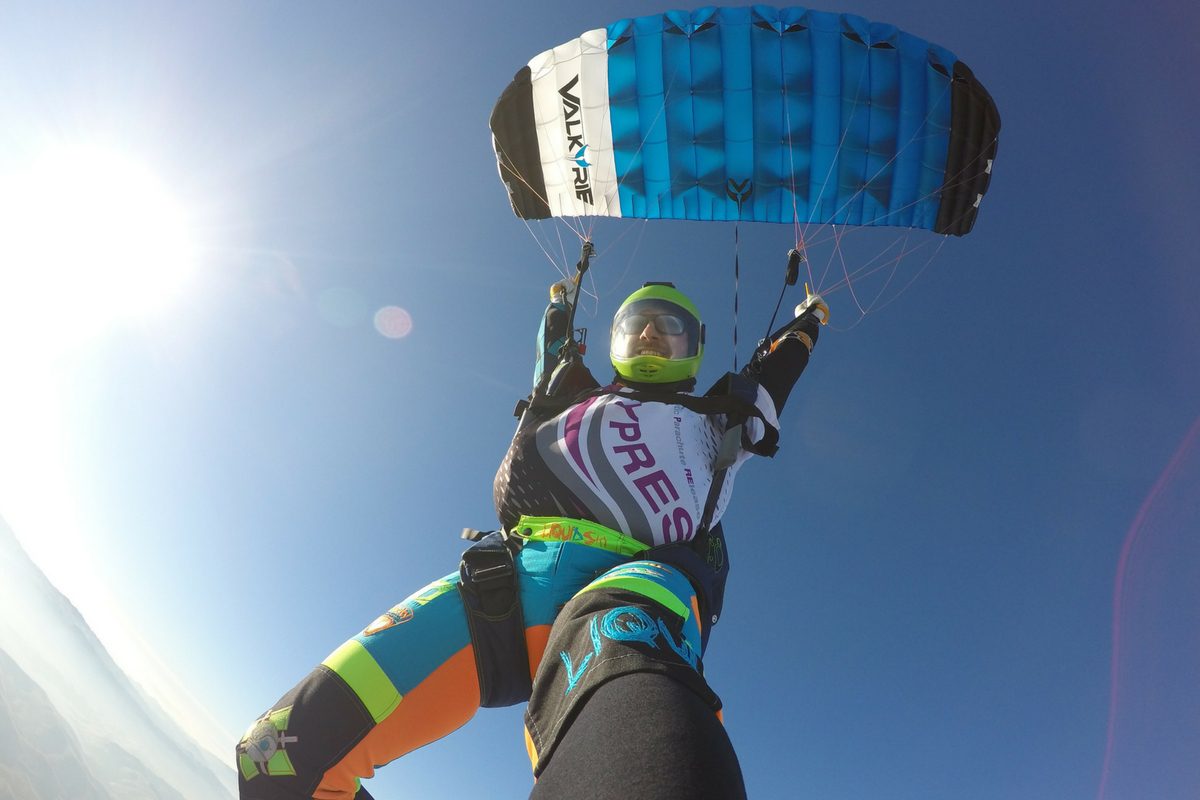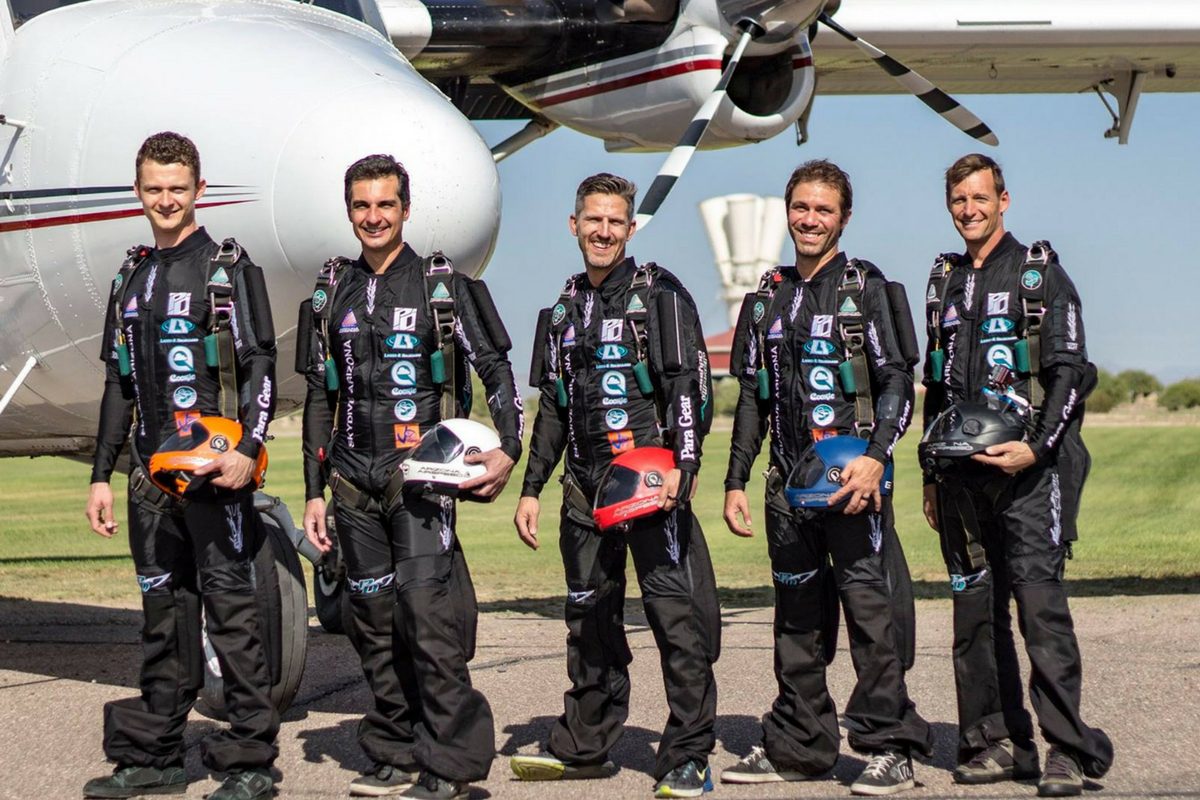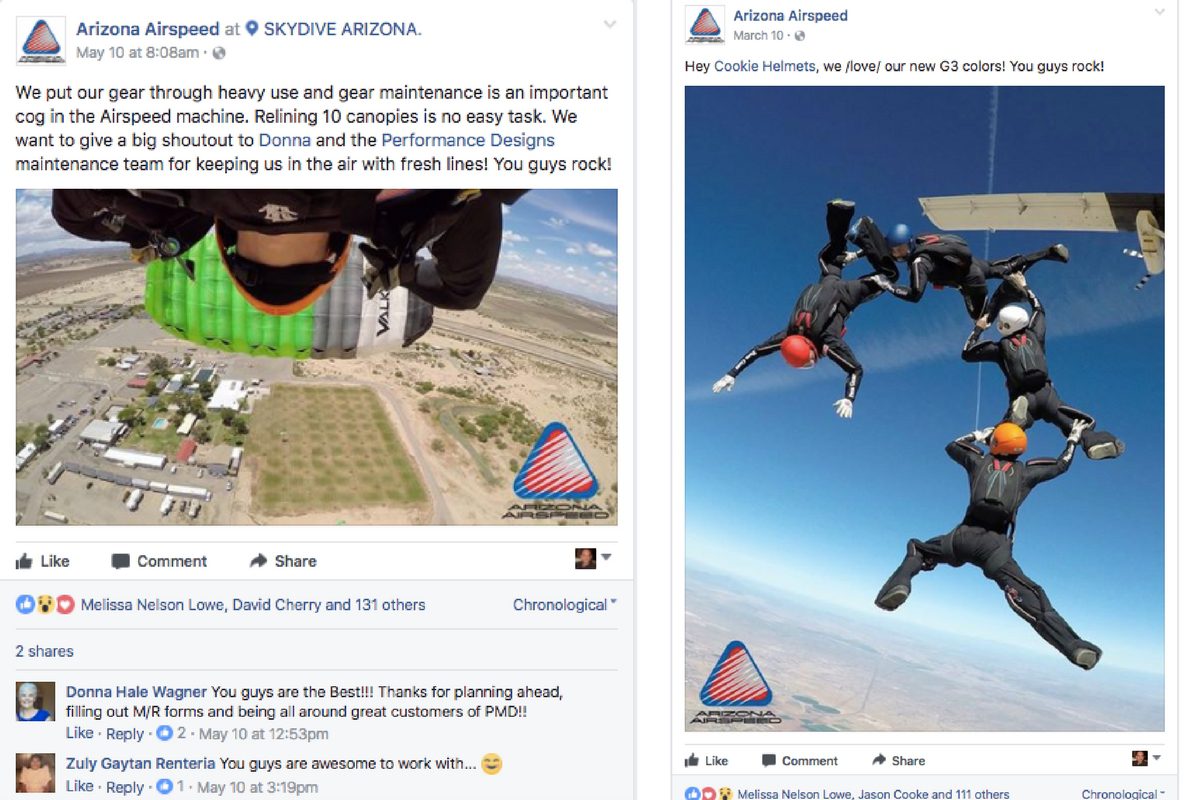
Photo by Zach Lewis
How To Win and Keep Skydiving Sponsors
In the world of skydiving, it’s the badge of honor. To have the logos of manufacturers professionally embroidered on your jumpsuit alerts others that you have status. These logos are symbols of past accomplishments, expectations of future success or that you’re a highly skilled and dynamic ambassador. No matter the classification, these logos are valued by those who don’t have them as they represent something magical… FREE GEAR.
In 2016, while working with several manufacturers, I learned of several common pain points as it related to sponsored athletes. It seems that many, as in a lot, are not holding up the minimum end of their bargain. These pain points were intriguing to me because my marketing brain looks for mediocrity. Where there is mediocrity, there is an opportunity for someone else.
With my curiosity piqued, I contacted several friends at various skydiving companies and asked them what their pain points were with their individual sponsorship programs. The result was some great information that I think every skydiver dreaming of sponsorship should learn before applying. If you understand the pain points, then you’ll know what to avoid and how best to formulate a strategy to stand out. Here I’ll share the pain points and ten steps to winning and keeping sponsorship.
The Pain Points
PAIN POINT 1 – NEVER BE CASUAL
Rather than putting this in my words, I’ll quote a representative from a major manufacturer who weighed in on this point concisely:
“Never ask the question, ‘What do I have to do, to get sponsorship?’ Don’t ask that, EVER. Not even as a joke because you think the sponsorship rep is your buddy. They are not your buddy when it comes to sponsorship. Unfortunately, there are a few people who are not sponsored by ____________ because they didn’t differentiate between friends and business.”
PAIN POINT 2 – NO FOLLOW THRU
If you say you’re going to do something, do it. Some wise words from a different manufacturer’s rep:
“Often once the skydiver gets their “free shit,” it is nearly impossible to get anything in return. They feel they deserve the free shit just because they are ‘hot shit.’”
Did you catch that sense of frustration? I’d pay close attention to this pain point because it happens too often with every manufacturer.

PAIN POINT 3 – EXPECTATIONS NOT IN LINE WITH REALITY
Though these major skydiving brands are big business, their market is pretty small. In the words of another manufacturer’s representative:
“Many, if not most skydivers mistake the parachute industry for other mainstream consumer product markets. The marketing budget for sponsorships is not quite like Red Bull.”
PAIN POINT 4 – SPONSORSHIP IS NOT FREE
In my first paragraph, I mentioned that skydivers desire product support because they want free stuff. It’s reality check time. It’s not free.
Recognize that the monetary value given is expected in return. This is called ROI – return on investment. Sponsors are investing in you, and they expect a return. Sponsorship isn’t a free ride, but rather a business agreement. There’s no faster way to burn your reputation and any hopes for future sponsorships if you don’t recognize this immediately.
And another note: don’t think for a second the manufacturers don’t speak to one another. The majority are within a mile of each other in Deland, and they interact when they see each other on the road at boogies as well as industry meet-ups in all skydiving countries around the world. These guys do compare notes, especially when they get burned.
Another thought: Think of a world class skydiving team.
Got one in mind? Good.
Now, can you name all of their sponsors?
Furthermore, would you buy a particular product just because that team uses it? Some reading this may say yes, but the vast majority of skydivers don’t make purchases valued at thousands of dollars because a team jumps a particular kind of gear.
Don’t feel entitled or feel that you’re deserving of sponsorship because you’re a national or world champion. The truth is the majority of non-competitive skydivers and weekend warriors don’t pay much attention to competitions.
With sponsorship, you’re going to have to work for it.

PAIN POINT 5 – LACK OF UNDERSTANDING THAT YOU’RE AN EXTENSION OF THE COMPANY
This point should seem obvious, but few understand it. As a sponsored athlete (whether it be a discount or “free stuff”) you are now a brand ambassador. It’s your duty to:
- Know the history of the company
- Know all there is to know about the product
- Know how your gear is different than that of the competitor’s
- Be professional in appearance and attitude
REP QUOTE:
“More than once, we’ve been surprised to hear of our sponsored athletes verbally trashing our gear.”
PRO TIP: This industry is small. Word travels fast. Don’t speak negatively about those who are being good to you.
PAIN POINT 6 – SHOPPING AROUND
Ask yourself: Are you looking for free stuff from anyone or are you genuinely passionate about one particular brand that you want to use and want to represent?
REP QUOTE:
“There is a difference between approaching more than one manufacturer, professionally and honestly, and simply hunting for a great price on gear, yet so many potential athletes create a blanket presentation and send it to several manufacturers…Some even send it in ONE e-mail, and even worse, some have done that without putting the recipients in the BCC line.
Instead, athletes who are only hunting for the best price should approach dealers. They should ask about the possibility of a deeper than normal discount off the list price based on a 3-5 rig purchase.”
The pain points listed above are the primary points of contention, but there’s more… too much for this article, but with this information you should be better setup with ideas of what not to do.
10 Steps To Winning Sponsorship
Step 1: Solve all the pain points listed above.

Step 2: Create an incredible proposal for sponsorship.
The expression, “You only have one chance to make a great first impression” really applies here. Don’t e-mail your proposal, mail it, then send an e-mail follow-up. Use high-end paper. Be clear on your bio(s); who you are, why you love the product, why you want to represent it and how you’ll create a positive ROI. Remember, it’s not what they can do for you; it’s what you can do for them.
There is a lot of mediocrity out there, which means there’s great opportunity to stand out, so KILL.YOUR.PROPOSAL with every detail. The mental approach should be that your applying for the job you’ve dreamed about. Few people put in that level of effort, so this is a great opportunity to stand out.
Step 3 – Do what you say you’ll do and then over-deliver.
If you say you’ll deliver 10 great photos per month, submit 20. If you say you’ll be sure to share content from the sponsor’s Facebook page… share everything! You get the idea. Go BIG.

Step 4 – Reduce risk for the manufacturer wherever possible.
Recognize that sponsoring a team (especially a 4-way team) can be expensive. Mitigate the risk wherever possible.
EXAMPLE: Setup, your team as a business. When applying for sponsorship, the rigs belong to the team (company) not the individuals on the team. This way, when a team member has to opt out for whatever reason, the rig doesn’t depart with the individual. Few things are more frustrating for a manufacturer to see their sponsored gear being put up for sale after a team member has left with it while the team is asking for a new rig for the new teammate. #seriously?
Step 5 – Have a great attitude. Always. Everywhere. No one likes a skygod.
While your level of sponsorship is usually congruent to your resumé, there are tons of examples of people in the sport who are fully sponsored because they have amazingly positive attitudes. All brands in the world want to associate with a powerful force of energy that’s light, bright, inclusive, approachable and full of fun. Showcase that, and you’ll move up the sponsor scale faster.
Step 6 – Figure out how to exceed expectations.
Look around to see what the best athletes are doing for their sponsors and then figure out how to improve what they’re doing. Remember, you’ve got to do more than the next guy if you’re going to win the favor of manufacturer’s who sometimes receive 30 sponsor applications a week!
- Ask if there’s anything you can do. Pitch ideas. Don’t wait to be asked.
- Offer to donate your time as an LO
- Offer to pack for a day during a boogie (this can reflect direct ROI as manufacturers usually hire a packer to pack their demo canopies).
- Assist with tent setup at an event. It’s tedious work that’s made a lot easier with more than one person setting up.
Above: This is a great example of exceeding expectations. SDC Rhythm XP are ambassadors for the brands they represent and the sport. In the video example above, they don’t have to do this, but by giving back they’re building goodwill (positive vibes). As the value of the Rhythm XP’s brand increases so does their value to their sponsors. Taking a leadership role by being influencers in the sport is a lot of work but is the true definition of being a professional athlete. The way SDC Rhythm XP operates is the finest example of a sponsor-athlete relationship. Rhythm XP not only hosts camps at Paraclete XP (ROI for that sponsor), but also builds goodwill for their sponsor via SDC Rhythm XP’s professionalism. This is the perfect complement where the brand is enhanced by the team and the team is enhanced by the brand.
Lastly, while not specifically pointing out sponsors, there’s a lot of product placement throughout this video which is excellent for sponsors as this video adds value to that sponsors users. Also, this is great content for the sponsor’s marketing team who are always looking for great content. Well done SDC Rhythm XP!
Step 7 – Be a content marketer.
A challenge for any marketing department in any company (in or out of skydiving) is generating good content. Make the life of the marketing department easier, and you will quickly gain favor.
Generate content like:
- Submit your best photos every month
- Build a strong social presence for your team and update your page regularly tagging sponsors so they can share your stuff
- Use correct sponsor #tags on social
- Create videos highlighting your team and sponsors
- Use Facebook LIVE to give team updates and be sure to thank your sponsors
- Maintain a team blog regularly allowing the sponsors to have content to share for their social media. Example: “Our Journey to Nationals Sponsored by Sun Path.”
- Generate content for magazines and be sure to thank your sponsors.
Step 8 – Communicate.
Build a rapport with your sponsor and stay on their radar. Often, the marketing department will be asked by their bosses about details of specific teams. Make them look good by providing information with what’s happening with your team. They do want to know.
- Check in at least twice per quarter
- Create and submit team reports
- Submit photos and gear feedback until you are told to stop
REP QUOTE:
“Even if you’re told to stop, keep collecting and cataloging them both for submission later. Our best teams send me pictures after every event or camp and gear feedback quarterly. Usually, the photos come as a link to some file sharing site like wetransfer.com, or a Dropbox folder.
Every photo does NOT have to be magazine cover worthy. Just send photos where smiles and product logos are visible. Let the graphic artist at the manufacturer worry about how to use them.
Positive gear feedback should come in short bullet comments that can be easily quoted in print and online adverts.
‘Needs improvement’ feedback should come in the form of an e-mail with supporting photos or video.”
Step 9 – Know How To Say Thank You
There are few things ruder than when a sponsor selects you to represent them, and you don’t have the common courtesy to say “thank you” at the end of the season. Remember earlier when I said mediocrity opens opportunity? This is an area where you can make your mark as many individuals and teams fall short in this area. How you say thank you can be as important as your proposal at the beginning. Leave a lasting mark by being creative and thoughtful.
- Write handwritten letters of thanks to the Marketing Director / Director of Sponsorship
- Write a handwritten letter to the owner of the company thanking them for creating a great product and for their sponsorship
- Send a coffee table photo book showcasing photos from the season with the sponsor’s products being used
- Create plaques/awards of gratitude
- Take an ad out in a magazine publicly thanking your sponsors
- Showcase your sponsors prevalently on the homepage of your team website
Step 10 – Show Your Worth
It’s not a bad idea to show your worth at the end of the season. Create a report highlighting all you said you’d do, what you did and how you executed it. Show sales figures of purchases made by others due to your influence and share what you learned and how you’ll do things differently for the following season. Remember, the marketing department is juggling a lot of teams and will be receiving a whole new set of applications for the next season; be sure they know your worth!
This month’s submission was super long, but I hope you were able to get value out of it! Now go get some sponsorship!
Have questions about sponsorship? Contact me: james@amazethecustomer.com.




